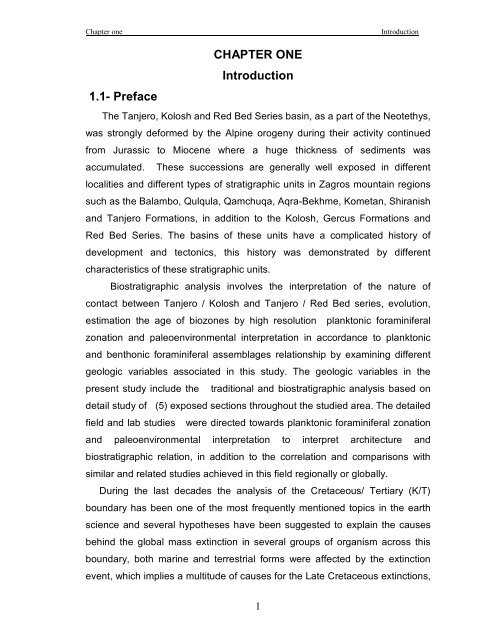biostratigraphy and paleoecology of cretaceous/tertiary boundary in ...
biostratigraphy and paleoecology of cretaceous/tertiary boundary in ...
biostratigraphy and paleoecology of cretaceous/tertiary boundary in ...
You also want an ePaper? Increase the reach of your titles
YUMPU automatically turns print PDFs into web optimized ePapers that Google loves.
Chapter one<br />
Introduction<br />
CHAPTER ONE<br />
Introduction<br />
1.1- Preface<br />
The Tanjero, Kolosh <strong>and</strong> Red Bed Series bas<strong>in</strong>, as a part <strong>of</strong> the Neotethys,<br />
was strongly deformed by the Alp<strong>in</strong>e orogeny dur<strong>in</strong>g their activity cont<strong>in</strong>ued<br />
from Jurassic to Miocene where a huge thickness <strong>of</strong> sediments was<br />
accumulated. These successions are generally well exposed <strong>in</strong> different<br />
localities <strong>and</strong> different types <strong>of</strong> stratigraphic units <strong>in</strong> Zagros mounta<strong>in</strong> regions<br />
such as the Balambo, Qulqula, Qamchuqa, Aqra-Bekhme, Kometan, Shiranish<br />
<strong>and</strong> Tanjero Formations, <strong>in</strong> addition to the Kolosh, Gercus Formations <strong>and</strong><br />
Red Bed Series. The bas<strong>in</strong>s <strong>of</strong> these units have a complicated history <strong>of</strong><br />
development <strong>and</strong> tectonics, this history was demonstrated by different<br />
characteristics <strong>of</strong> these stratigraphic units.<br />
Biostratigraphic analysis <strong>in</strong>volves the <strong>in</strong>terpretation <strong>of</strong> the nature <strong>of</strong><br />
contact between Tanjero / Kolosh <strong>and</strong> Tanjero / Red Bed series, evolution,<br />
estimation the age <strong>of</strong> biozones by high resolution planktonic foram<strong>in</strong>iferal<br />
zonation <strong>and</strong> paleoenvironmental <strong>in</strong>terpretation <strong>in</strong> accordance to planktonic<br />
<strong>and</strong> benthonic foram<strong>in</strong>iferal assemblages relationship by exam<strong>in</strong><strong>in</strong>g different<br />
geologic variables associated <strong>in</strong> this study. The geologic variables <strong>in</strong> the<br />
present study <strong>in</strong>clude the traditional <strong>and</strong> biostratigraphic analysis based on<br />
detail study <strong>of</strong> (5) exposed sections throughout the studied area. The detailed<br />
field <strong>and</strong> lab studies were directed towards planktonic foram<strong>in</strong>iferal zonation<br />
<strong>and</strong> paleoenvironmental <strong>in</strong>terpretation to <strong>in</strong>terpret architecture <strong>and</strong><br />
biostratigraphic relation, <strong>in</strong> addition to the correlation <strong>and</strong> comparisons with<br />
similar <strong>and</strong> related studies achieved <strong>in</strong> this field regionally or globally.<br />
Dur<strong>in</strong>g the last decades the analysis <strong>of</strong> the Cretaceous/ Tertiary (K/T)<br />
<strong>boundary</strong> has been one <strong>of</strong> the most frequently mentioned topics <strong>in</strong> the earth<br />
science <strong>and</strong> several hypotheses have been suggested to expla<strong>in</strong> the causes<br />
beh<strong>in</strong>d the global mass ext<strong>in</strong>ction <strong>in</strong> several groups <strong>of</strong> organism across this<br />
<strong>boundary</strong>, both mar<strong>in</strong>e <strong>and</strong> terrestrial forms were affected by the ext<strong>in</strong>ction<br />
event, which implies a multitude <strong>of</strong> causes for the Late Cretaceous ext<strong>in</strong>ctions,<br />
1

















